It’s scientifically proven when you have a pet, your mind relaxes and you feel less stressed. We usually like to have cats, dogs, bunnies, birds, etc as pets. However, for many reasons, such as building regulations, allergies, or simply not being able to take care of such a big animal; people can’t have these animals as pets.
Tree frogs can be a great alternative to these. But, which one? The best pet tree frogs to have as a pet would be White’s tree frog, squirrel tree frog, red-eyed tree frog, clown tree frog, etc. Each frog has its own requirements, including tank conditions, food, and other needs.
Let’s take a look at some of the best tree frogs you can have as pets. While we are at it, we’ll also take a look at how you can ensure your pet frog’s safety and comfort.

What are the best tree frogs to keep as pets?
Nowadays, people are more and more leaning toward keeping unorthodox pets such as frogs, toads, and lizards as pets. This is because they don’t occupy much space, keep to themselves, and don’t break any rules some buildings might have.
Accordion to the National Wildlife Federation, there are over 800 species of tree frogs in the world. 600 of them reside in central and southern America. Due to their wide variety, tree frogs have become one of the most popular pets among owners. Here are some of the best tree frogs to keep as pets are:
1. White’s Tree frog
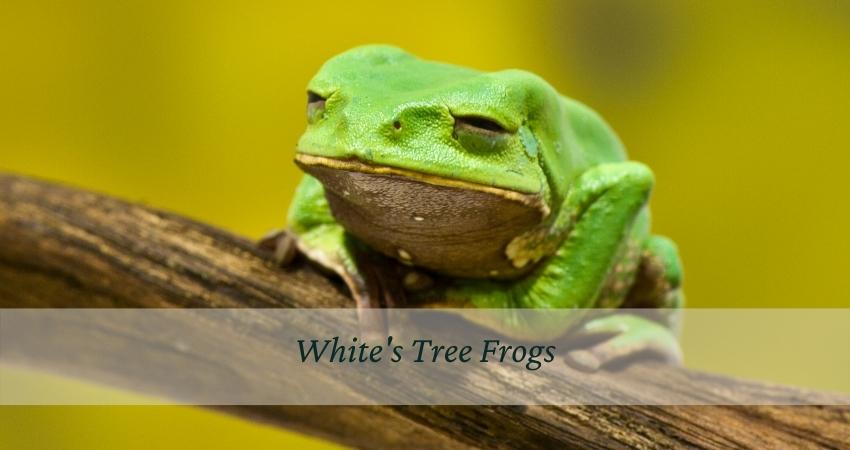
One of the largest tree frogs to be kept as pets, the White’s tree frog grows to about four to five inches in length. They also live for around twenty years in captivity, so it’s worth it to have them as pets. They live in Australia, New Zealand, and New Guinea.
Sometimes called Dumpy tree frogs, these frogs come in a lot of color patterns dominated by green: Silver green, blue-green, or just green. Their coloring makes them adorable. This coupled with their hardiness makes these frogs an ideal pet to have.
As long as their tank conditions go, the White’s tree frogs need a tank of 20 gallons. The walls of the tank should be high as these frogs are very good climbers, like all tree frogs. Ensure the lid of the tank is tightly sealed so that it can’t climb out of it.
A rule of thumb for keeping tree frogs as pets is that you always need to have tree branches or vines in the tank. This is absolutely for the tree frogs as they like to spend most of their time on elevated surfaces like these.
White’s tree frogs can be cannibalistic. They’re kept in tanks individually for that reason. If you do intend to keep more than one frog in a tank, then ensure the frogs are of the same size. If not, the bigger one will eat the smaller frog.
Additional Read: What Tree Frogs Can Live Together?
Speaking of food, White’s tree frogs mainly eat crickets. You can also feed them other insects such as grasshoppers, beetles, earthworms, etc. As these frogs are nocturnal, you need to feed them at night.
While keeping these tree frogs as pets, note that they croak quite often. They croak in the rainy season as it’s their mating season. But they also croak due to loud sounds made by vacuum cleaners, vehicles etc. So keep this in mind while placing a tank for the White’s tree frogs.
Read More: Are White’s Tree Frogs Poisonous?
2. Squirrel Tree frog
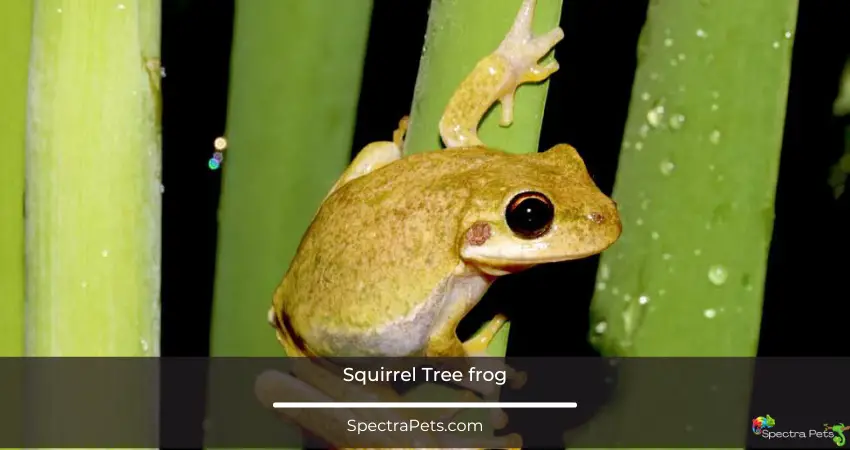
Squirrel tree frogs are one of the smallest tree frogs that people keep as pets. They only grow to about one and a half inches as an adult. They are excellent pets, living up to 9 years in captivity.
These tree frogs are colorful animals, with their color pattern resembling that of a chameleon. You can find these frogs all along the coastal region of the United states’ southeast region. They live in areas that are wet, such as swamps, marshes, etc.
These frogs are mostly nocturnal, so feeding them live insects is a good idea. Although they also are active during rainy days in the wild, while in captivity, you shouldn’t worry about this too much.
Since they live in wet areas, their tank needs to be moist and humid. You also have to have a fresh supply of water along with tree branches for them to soak themselves and climb on respectively.
3. Clown Tree Frog
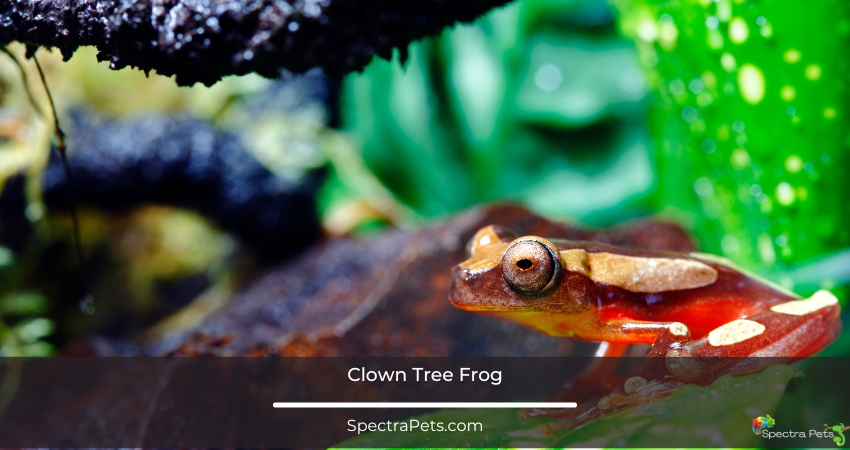
The Clown tree frog is a rare species. This along with its unique coloring makes these frogs an attractive choice when it comes to pets. They get their name due to the color pattern on their body, which resembles a clown’s attire.
One attribute that separates the Clown tree frog from most pet frogs is its loudness. As they are very vocal, you have to keep the tank as far away from your bedroom as possible to ensure sound sleep.
The clown tree frog is a high-maintenance frog, so it’s not suited for beginners. They need their tank conditions to be exactly correct. They are also not very hardy, so you always have to tend to their needs.
4. Red Eyed tree frogs

The red-eyed tree frog is yet another small-sized amphibian that you can keep as a pet. These frogs can be found in central and south America’s rainforests. These frogs come in a whole host of colors, from orange to blue to green. Their distinctive feature is their red eyes.
These frogs are insectivores, so you can feed any type of insect them which aren’t harmful to them. But as they are being kept in captivity, they can’t produce calcium. To help them with that, you must dust their food with calcium supplements.
The Red-eyed tree frogs live in groups. So it’s better to keep at least two of them in a tank. The tank has to be of at least 20 gallons size with tall walls. Ensure there are plenty of branches, vines, etc. for the frogs to climb on.
Red-eyed tree frogs have a very particular humidity requirement. Since they live in rainforests, they need very humid conditions inside their tanks. Keeping coconut fibers as substrates will help keep the tank humid.
The Red-eyed tree frogs are nocturnal. So the best time to feed these frogs is during the night. Keep the food inside the tank overnight and then remove the uneaten food (if any) in the morning.
Like the Clown tree frogs, these frogs are also high-maintenance and fragile frogs. So if you are new to keeping frogs as pets, it’s best to avoid having them.
5. The Waxy monkey tree frog
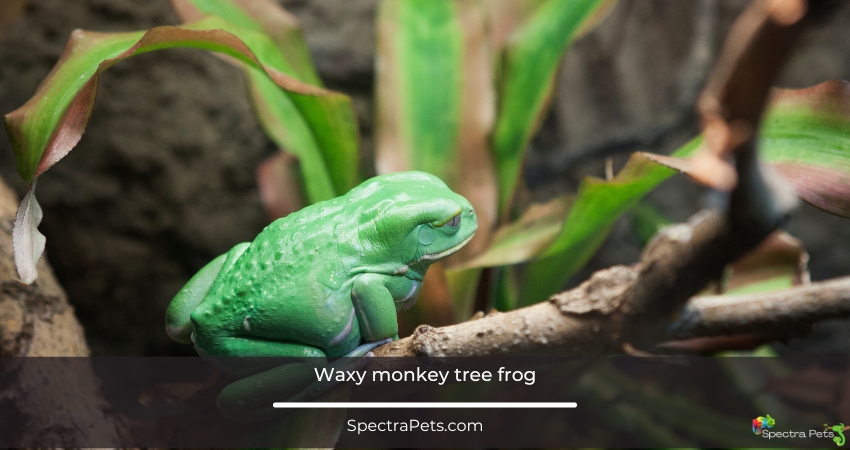
Native to South America, the Waxy monkey tree frog is a medium-sized tree frog. It grows to about three inches. Like their length, their lifespan is also medium, as they live for around eight years.
Unlike the previously mentioned frogs, the waxy monkey tree frogs don’t live in rainforests. Their habitats are a little drier, so keep this in mind when designing a tank for them. Speaking of tanks, the ones for the Waxy monkey frogs should be 20 gallons. Ensure there are a lot of branches for them to climb on. Also, these frogs need a lot of ventilation. So instead of solid lids, make sure the tops of the tanks are made of mesh wire.
As they come from drier conditions, they need around 50% humidity in the tanks. The daytime temperature should be at most 82 degrees Fahrenheit while that at night should be a maximum of 75°F.
The favorite food of Waxy monkey tree frogs is crickets. Feeding the frogs these insects after dusting them with calcium supplements twice or thrice a week is a good idea. Also, as the frogs are nocturnal, feed them at night.
6. The White-lipped tree frogs
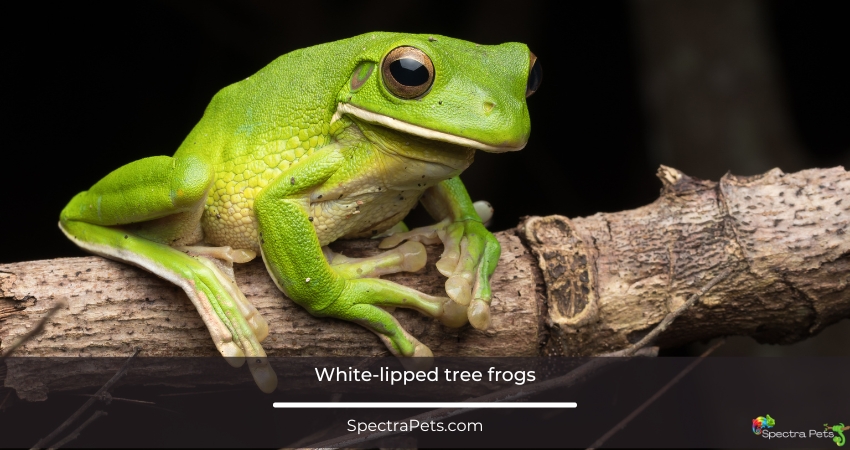
The White-lipped tree frogs are green in color with a white stripe on their lips. Native to Australia and New Guinea like the White’s tree frog, they are also the largest tree frogs to be kept as pets. These animals grow to around 5.5 inches in length when fully grown.
The ideal size of a tank for these large frogs is around 55 gallons and must have tall walls to prevent them from climbing off the tank. The tank also must have branches so that they can climb and stay on them.
These frogs live a long time, from 10 to 15 years which makes them a very good pet to have. But people, especially rookies don’t tend to keep them as pets as they are not very hardy. If you intend to have a White-lipped tree frog, you must tend to it regularly.
7. The Pacific Tree frog
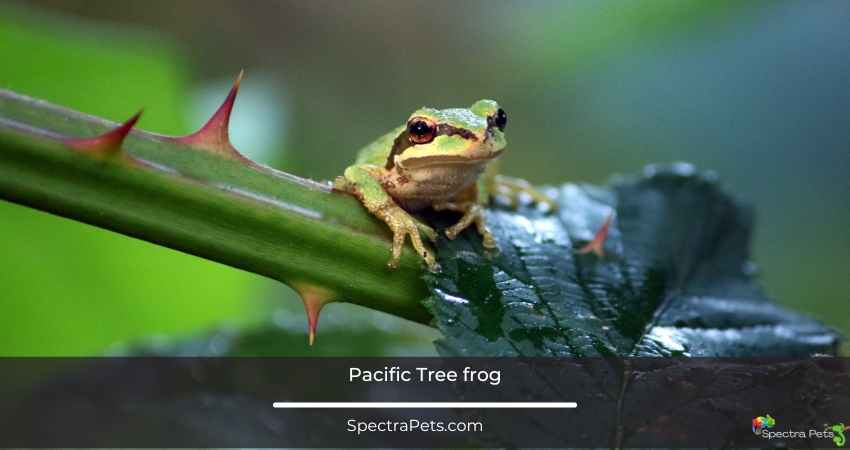
On the other side of the coin, we have the Pacific tree frog. These are one of the smallest frogs on this list, growing to only a couple of inches long. Like their sizes, their lifespan is also very small, as they only live up to about two years. But in captivity, they can live for a little longer.
Unlike other frogs in this list, these frogs don’t need a tank of 20+ gallons in size. Just a 10-gallon tank should be just fine for a single frog. You can keep multiple Pacific tree frogs together, in which case, the tank size should be increased by 20 gallons for each frog.
They don’t need too much humidity in their tanks, so the tank’s top should be made of mesh metal. This top also will ensure proper ventilation. The mesh top has to be sealed tightly to prevent the frogs from escaping. You should always have a source of fresh water for the betterment of the frogs.
Apart from the usual branches for the Pacific tree frogs to climb on, you also need to have at least one log. Because these frogs love to hide under logs most of the time, especially during the day. Being nocturnal they feed at night. So place live food in the tank at night after dusting them with calcium supplements.
8. Gray Tree frog

Native to North America, Gray tree frogs are an excellent choice to have as pets. They also have quite a positive impact on the environment and local agriculture by eating harmful insects. This should give you an idea about their diet.
The Gray tree frog is one of the longest-living frogs on this list, living for up to 15 years in captivity, which is almost twice their lifespan in the wild. This long lifespan alone makes them excellent choices for pets.
When choosing a tank for Gray tree frogs, ensure that it is 20 gallons in size and has tall walls. Apart from having branches to climb on, you also need live plants in your tank. Because like the aforementioned Pacific tree frogs, they also like to hide. But unlike Pacific tree frogs, they like to do so among live plants.
As mentioned earlier, Gray tree frogs love to eat insects. So, feeding them insects such as crickets after dusting them with vitamin and calcium supplements is a good idea. These frogs are voracious eaters, so make sure not to overfeed them. Also, you must have a constant supply of fresh water inside their tanks.
Read More: Are Gray Tree Frogs Poisonous?
9. American green tree frog
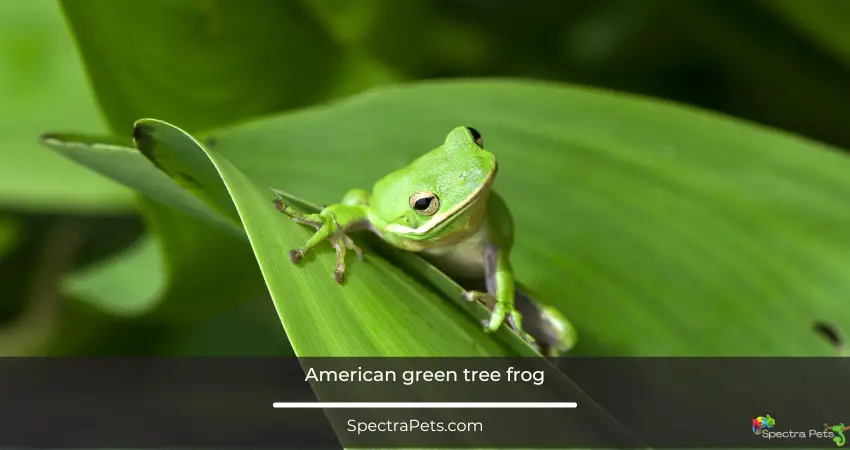
Found in wet areas of the USA, these frogs are very small. They only grow to about two inches in length as adults. If you are a novice and don’t have a large-sized tank, then this frog is one of the best choices for you. You only need a tank of about 10 gallons for an American green tree frog.
American green tree frogs eat a lot of insects and worms. So you can feed them crickets, ants, waxworms, etc. These frogs also need supplements along with their regular food. So dust the live food with vitamin supplements as well as calcium supplements before feeding them.
Have branches and small tree-like structures inside the tank for the frogs to be able to climb on. Don’t handle these frogs as they don’t like to be handled. American tree frogs don’t have any specific temperature requirements as long as the room temperature remains above 70°F.
Read More: Are Green Tree Frogs Poisonous?
10. Barking Tree frog
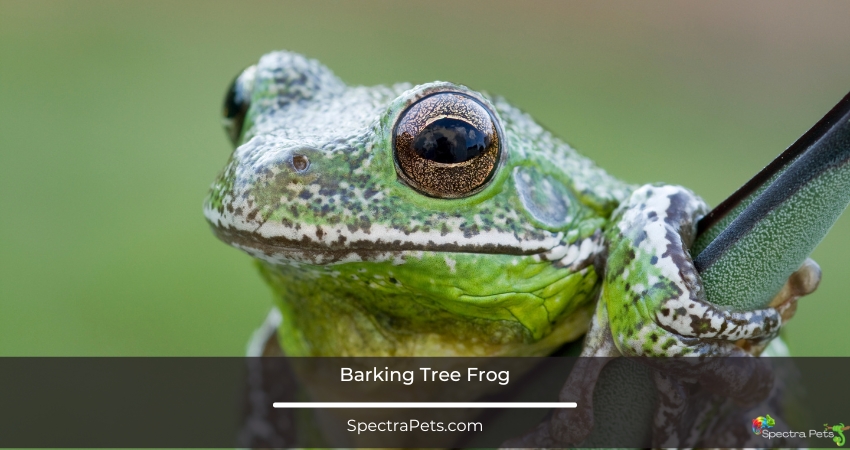
Yet another tree frog native to North America, the Barking tree frog is a medium-sized frog. They grow close to three inches in length. Living for up to 10 years in captivity, these frogs are an excellent choice for beginners. These frogs get their name from the sound they make during the mating season, which resembles the barking of a dog.
An interesting characteristic of the Barking tree frog is that it can change its color according to its mood. If the frog is happy, its color is green. On the other hand, being irritated makes it brown, dark green, or gray. So you can easily determine how the animal is feeling by looking at its color.
A Barking tree frog needs to have a tank of 15-20 gallons in size with tall walls. As they need ventilation, the top of the tank should be of mesh wiring. Not only will this top ensure ventilation, but it will also control the humidity level in the tank. You must have fresh water inside the tank, as these frogs love to sit and swim in the water.
Keep branches and plants inside the tank for the Barking tree frog to climb on. These frogs love food, so feed them crickets at night. The food must be dusted with supplements to ensure their health.
11. Cuban tree frog
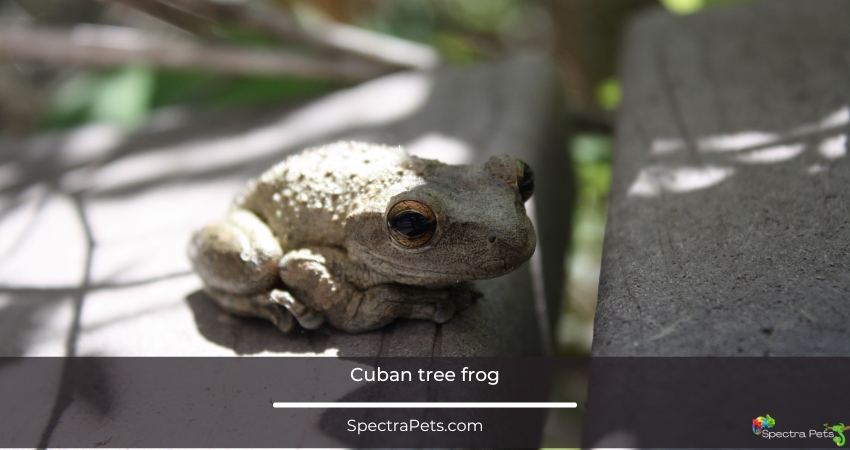
One of the largest tree frogs in the world, the Cuban tree frog can be found in Cuba and the US. They grow to around five inches in length. In captivity, they can live for around 5 years. These frogs also sound like barking dogs like the Barking tree frogs during the mating season.
Also, like the Barking tree frogs, they can change their skin color according to their surroundings as well as their mood. They also don’t like to be handled. They will first change color to express their displeasure and then will try to escape from your hand. So don’t try to handle them unless it’s necessary, as they can hurt themselves trying to get away from you.
The Cuban tree frogs are voracious eaters, and they love crickets. You should feed them thrice every week and the feeding time shouldn’t be more than 20 minutes. You can also feed the grown-up frogs pinky mice as occasional treats.
You need to have a 20-gallon tank with walls that are considerably tall for a Cuban tree frog. The tank must have branches and other plants and leaves. They also like to swim, so ensure you have enough freshwater in the tank. Other than that, these frogs love to hide, so keep either a log or half a coconut in the tank as well.
The required humidity level for Cuban tree frogs is 60%. Keeping water inside the tank should take care of that. If it doesn’t, mist the tank regularly to maintain the humidity level.
What should you feed your tree frogs?
The best way to ensure your pet frog’s good health is to feed them regularly. But you can’t feed the frogs whatever you want. Usually, tree frogs are insectivores, so you can feed them various insects without any worry. Some frogs also eat other animals like mice, bats, or other frogs.
Here are a few common things you can feed your pet tree frog:
- Crickets
- Ants
- Beetles
- Flies
- Grasshoppers
- Moths
- Mosquitoes
- Smaller frogs
- Tadpoles
- Algae
- Supplements
Final Words
There are a lot of tree frog species that people want and have as pets. But the best pet tree frogs are the ones that suit the experience and the skillset of a pet owner. Some frogs suit beginners well, while others are better when in the hands of a more experienced pet owner. So before buying a tree frog to keep as a pet, research about it and then decide whether you’re up to the task or not.
